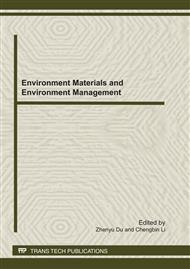[1]
Angelakis AN, Bontoux L. Wastewater reclamation and reuse in European countries. Water Policy 2001; 3: 47-59.
DOI: 10.1016/s1366-7017(00)00028-3
Google Scholar
[2]
Asano T, Cotruvo JA. Groudwater recharge with reclaimed municipal wasterwater: health and regulatory considerations. Water Res 2004; 38(8): 1941-(1951).
DOI: 10.1016/j.watres.2004.01.023
Google Scholar
[3]
Dillon P, Page D, Vanderzalm J, Pavelic P, Toze S, Bekele E, et al. A critical evaluation of combined engineered and aquifer treatment systems in water recycling. Water Sci Techinol 2008; 57(5): 753-762.
DOI: 10.2166/wst.2008.168
Google Scholar
[4]
Castro-Hermida JA, García-Presedo I, Almeida A, et al. Contribution of treated wastewater to the contamination of recreational river areas with Cryptosporidium spp. and Giardia duodenalis. Water Res 2008; 42(13): 3528–3538.
DOI: 10.1016/j.watres.2008.05.001
Google Scholar
[5]
Wéry N, Lhoutellier C, Ducray F et al. Behaviour of pathogenic and indicator bacteria during urban wastewater treatment and sludge composting, as revealed by quantitative PCR. Water Res 2008; 42(1–2): 53–62.
DOI: 10.1016/j.watres.2007.06.048
Google Scholar
[6]
A.N. Angelakis, L. Bontouxc. Wastewater reclamation and reuse in Eureau countries. Water Policy , 2001 (3): 47–59.
DOI: 10.1016/s1366-7017(00)00028-3
Google Scholar
[7]
D. Bixio,C. Thoeye, J. De Koning, et al. Wastewater reuse in EuropeDesalination 2006(187 ) : 89–101.
DOI: 10.1016/j.desal.2005.04.070
Google Scholar
[8]
A.N. Angelakis,B. DurhamWater recycling and reuse in EUREAU countries: Trends and challenges. Desalination 2008 (218) : 3–12.
DOI: 10.1016/j.desal.2006.07.015
Google Scholar
[9]
Maeda,M., Nakada,K., Kawamoto, K et al. Area-wide Use of Recalimed Water in Tokyo , Japan. Wat. Sci. Tech. 1996, 33(10-11).
DOI: 10.2166/wst.1996.0661
Google Scholar
[10]
T. Asano,M. Maeda,M. Takaki. Wasterwater reclamation and reuse in Japan: overview and implementation examples. Wat. Sci. Tech. 1996, 34: 219-226.
DOI: 10.2166/wst.1996.0283
Google Scholar
[11]
James Crook, Rao Y. Sruampalli. Water reclamtion and reuse criteria in the U.S. Wat. Sci. Tech. 1996, 33: 451-462.
Google Scholar
[12]
Wu junsen, Li hengjun. The Wastewater Treatment And Regneration In Cities. Journal of Shandong Normal University(Natural Science). 2005, (20)3: 69-71.
Google Scholar
[13]
Murni Po, Juliane D. Kaercher and Blair E. Nancarrow Literature review of factors influencing public perceptions of water reuse CSIRO Land and Water Technical Report 54/03, December (2003).
Google Scholar
[14]
C. Campos. New perspectives on microbiological water control for wastewater reuse. Desalination , 2008 , (218): 34–42.
DOI: 10.1016/j.desal.2007.08.002
Google Scholar
[15]
H. Leclerc, S Eberg, V Pierzo and J. Delatte, Bacteriophagesas indicators of enteric viruses and public health in groundwaters. Microbiol., 2000(88) : 5–21.
DOI: 10.1046/j.1365-2672.2000.00949.x
Google Scholar
[16]
Harwood, V. J, Levine, A. D, Scott, T. M, et al . Validity of the indicator organismparadigm for pathogen reduction in reclaimed water and public health protection. Environ. Microbiol. 2005, 71: 3163–3170.
DOI: 10.1128/aem.71.6.3163-3170.2005
Google Scholar
[17]
Duran, A.E., Muniesa, M., Moce´-Llivina, L., et al. Usefulness of different groups ofbacteriophages as model micro-organisms for evaluatingchlorination. Microbiol. 2003, 95: 29–37.
DOI: 10.1046/j.1365-2672.2003.t01-1-01948.x
Google Scholar
[18]
Jacangelo, J.G., Loughran, P., Petrik, B., et al. Removal of enteric viruses and selected microbialindicators by UV irradiation of secondary effluent. Water Sci. Technol. 2003, 47,: 193–198.
DOI: 10.2166/wst.2003.0522
Google Scholar
[19]
Ana Costa´n-Longaresa, Michel Montemayora, Andrey Paya´na, et al. Microbial indicators and pathogens: Removal, relationships and predictive capabilities in water reclamation facilities. Water R e s e arch 2 0 0 8 , (4 2 ) : 4 4 3 9 – 4 4 4 8.
Google Scholar
[20]
Caterina Levantesi , Rosanna La Mantia , Costantino Masciopinto, et al. Quantification of pathogenic microorganisms and microbial indicators in threewastewater reclamation and managed aquifer recharge facilities in Europe. Science of the Total Environment 2010 (408) : 4923–4930.
DOI: 10.1016/j.scitotenv.2010.07.042
Google Scholar
[21]
Graham Wilkes, Thomas Edg, Victor Gannon, et al. Seasonal relationships among indicator bacteria, pathogenic bacteria, Cryptosporidium oocysts, Giardia cysts, and hydrological indices for surface waters within an agricultural landscape. WATER RESEARCH, 2 0 0 9, (4 3) : 2 2 0 9 – 2 2 2 3.
DOI: 10.1016/j.watres.2009.01.033
Google Scholar
[22]
World Health Organisation (WHO). Guidelines for the safe use of wastewater, excretaand greywater. Wastewater use in agriculture, Volume 2. Geneva: World HealthOrganisation; (2006).
Google Scholar
[23]
Toze. Water reuse and health risks-real VS perceived. Desalination 2006, 187: 41-51.
DOI: 10.1016/j.desal.2005.04.066
Google Scholar
[24]
Kimberly L. Cook a, Michael J. Rothrock Jr. et al. Spatial and temporal changes in the microbial community in an anaerobic swine waste treatment lagoon. Anaerobe , 2010, (16): 74–82.
DOI: 10.1016/j.anaerobe.2009.06.003
Google Scholar
[25]
Graham Wilkes, Thomas Edg, Victor Gannon, et al. Seasonal relationships among indicator bacteria, pathogenic bacteria, Cryptosporidium oocysts, Giardia cysts, and hydrological indices for surface waters within an agricultural landscape. WATER RESEARCH, 2 0 0 9, (4 3) : 2 2 0 9 – 2 2 2 3.
DOI: 10.1016/j.watres.2009.01.033
Google Scholar
[26]
Anderson, K.L., Whitlock, J.E., Harwood, V.J. Persistence and differential survival of fecal indicator bacteria in subtropical waters and sediments. Environ. Microbiol. 2005, 71 (6): 3041–3048.
DOI: 10.1128/aem.71.6.3041-3048.2005
Google Scholar
[27]
Yates, M. V . Classical indicators in the 21st century – far and beyond the coliform. Water Environ. Res. 2007, 79 (3), 279–286.
DOI: 10.2175/106143006x123085
Google Scholar
[28]
Maxwell R M, Welty C, Tompson A F B. Streamline-based simulation of virus transport resulting from long term artificial recharge in a heterogeneous aquifer. Water Res, 2003, 26: 1075-1096.
DOI: 10.1016/s0309-1708(03)00074-5
Google Scholar
[29]
Davies CM, Kaucner C, Deere DA, et al. Recovery and enumerationof Cryptosporidium parvum from animal fecal matrices. Environ Microbiol 2003; 69(5): 2842– 2847.
DOI: 10.1128/aem.69.5.2842-2847.2003
Google Scholar
[30]
JinY, Chu Y, Li Y. virus removal and transport in saturated and unsaturated sand columns. Contam. Hydrol, 2000, 43: 111-128.
DOI: 10.1016/s0169-7722(00)00084-x
Google Scholar
[31]
Powell K L, Taylor R G, Cronin A A, et al. Microbial contamination of two urban sandstone aqrifers in the UK. Water Res. 2003, 37: 339-352.
DOI: 10.1016/s0043-1354(02)00280-4
Google Scholar
[32]
Quanrud D M, Carroll SM, Gerba CP, et al. virus removal during simulated soil-aquifer treatment. Water Res. 2003, 37: 753-762.
DOI: 10.1016/s0043-1354(02)00393-7
Google Scholar
[33]
Kimberly L. Cook a, Michael J. Rothrock Jr. et al. Spatial and temporal changes in the microbial community in an anaerobic swine waste treatment lagoon. Anaerobe , 2010, (16): 74–82.
DOI: 10.1016/j.anaerobe.2009.06.003
Google Scholar


